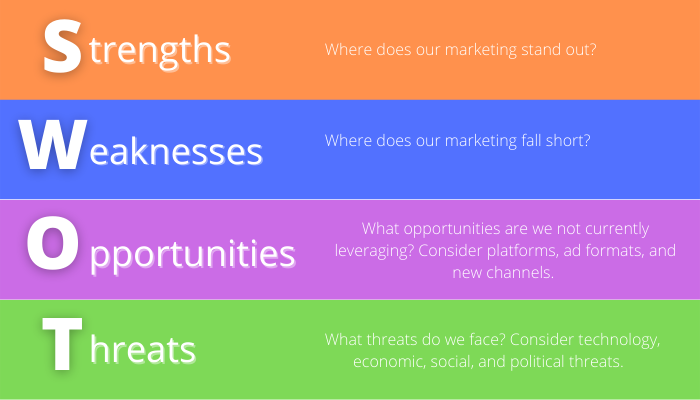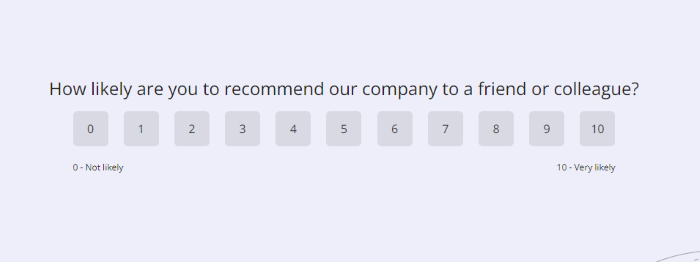If you want to win at content marketing, you need to make friends with the right people. Clemenger Media Sales is Australia’s best media buying agency, and we can help you target the market you want to own. We specialize in content marketing, media sponsorship, and advertising sales, so we can help you maximize your advertising ROI. Invest where your prospects live and buy the media where your customers live. We’ll help you with your media buying so you can focus on what you do best. Call or email us today to get started….
How to Do an Effective SWOT Analysis for Your Marketing Campaigns
How do you measure the effectiveness of your marketing campaigns? Do you track ROI? A/B test ads to improve performance? Maybe you use a fancy Google Data Studio dashboard to generate slick reports.
There’s still a good chance you are wasting money, and that’s because most businesses measure the impact of marketing after the fact. While knowing the cost per click of your search or social ads is essential, understanding the overall impact of your marketing campaigns can provide deeper insights into your business.
This is where SWOT analysis comes in handy. SWOT (strengths, weaknesses, opportunities, and threats) analysis for marketing campaigns allows you to see the big picture and face challenges head-on.
What Is a SWOT Analysis?
A SWOT analysis is a framework for analyzing and identifying key challenges affecting your business by considering your strengths, weaknesses, opportunities, and threats.
The goal of SWOT analysis is not just to track metrics or see which ads perform better but rather to get a high-level view of the impact of your marketing so you can improve it.

What Are the Benefits of SWOT Analysis in Marketing?
If you’ve run a Google Ad campaign or boosted a Facebook post, you already understand how to track the impact of your campaigns. A SWOT analysis looks beyond the standard metrics like ROI, CPC, and CAC to uncover the most crucial factors impacting your marketing—whether that is customer satisfaction, competitors squeezing you out of the market, or failure to promote your assets effectively.

See How My Agency Can Drive Massive Amounts of Traffic to Your Website
- SEO – unlock massive amounts of SEO traffic. See real results.
- Content Marketing – our team creates epic content that will get shared, get links, and attract traffic.
- Paid Media – effective paid strategies with clear ROI.
That data can be powerful, especially if it’s available when you need it the most. According to Airtable, 46 percent of marketers say lack of timely data holds their team back. A SWOT analysis can help.
A few other benefits of SWOT for marketing include:
- a better understanding of which marketing channels to focus on
- helps you address weaknesses in your ads or marketing assets
- makes it easier to see threats to your campaigns before they impact your bottom line
- enables you to leverage the assets and strengths you already have
- improves long-term goal setting for your marketing
The average business spends around 12 percent of its overall budget on marketing—a SWOT analysis ensures your budget is put to good use.
What Are the Drawbacks of SWOT in Marketing?
As much as I like SWOT analysis in marketing, it has some limitations. For starters, if you aren’t honest about your true shortcomings, a SWOT analysis won’t provide useful insights. This type of analysis requires self-reflection and honesty to be useful.
It can also be difficult to analyze very complex factors that could be either a weakness or a strength. For example, running ads on TikTok might have the highest cost and drive higher quality leads, which could be both a strength and a potential weakness.
A few other limitations to keep in mind:
- SWOT analyses can be time-intensive. Make sure you have the personnel and the time to invest before getting started.
- You might generate too many ideas on how to improve your marketing and get overwhelmed.
- It can generate a lot of data but doesn’t tell you how to use that data.
Understanding the limitations of a SWOT analysis can help marketers and business owners better prepare and improve their chances of success. Now that you know its limitations, how do you perform a SWOT analysis?
How to Perform a SWOT Analysis for Marketing Campaigns
The first step in performing a SWOT analysis for marketing is determining the scope. Do you want to look at your marketing as a whole or a specific part of your overall marketing strategy? For example, you might want to focus only on your content strategy, SEO, or a specific ad campaign. Defining the parameters of your analysis helps keep you focused.
Keep in mind, there’s no one right way to perform a SWOT analysis, and that’s because every business has a different marketing strategy and faces different threats.
This guide can help you get started, but feel free to skip questions that don’t make sense for your business and add questions that provide a more thorough view of your marketing campaigns.
1. Analyze Your Marketing Strengths
What do you do well? If you’re looking at a specific campaign, think about what elements of the campaign are really working. For example, does your landing page convert at a higher rate, or are ads with people more likely to earn clicks?

Start by asking these questions and documenting the answers. Adjust the questions as needed to focus on a campaign or your entire marketing strategy.
- What does your company (or your campaign) do better than others in your industry?
- What do your customers love most about your company/product/services?
- What positive attributes do customers associate with your brand?
- What is your unique selling proposition? Is it effective?
- What resources do you have that competitors don’t? This includes people, financial resources, and expertise.
- What campaigns are most successful? Consider not just conversions but also lifetime value and cost per acquisition.
Remember, your answers and the questions you ask might vary depending on whether you are analyzing a specific campaign or your marketing strategy as a whole.
How to Find Strength Data
Don’t answer the questions above off the top of your head. Instead, use data to inform your answers. Depending on your business, that might include the following steps:
- Perform a customer satisfaction survey, like a net promoter score, to understand how customers view your business.

- Pull campaign data from separate tools into one dashboard, like Power BI or Google Data Studio to better understand the most effective campaigns.
- Poll your employees to better understand your resources and how your team views your company.
2. Look for Your Marketing Weaknesses
This is often the most challenging part of a SWOT analysis. That’s because you have to be honest with yourself, and it can be hard to admit where campaigns have fallen short.
Start by asking questions. Again, feel free to adjust the wording to fit your campaign or overall strategy.
- What do your customers most dislike about your company or offering?
- What complaints are often mentioned in negative reviews?
- Why do customers churn?
- If you sell products, why don’t customers come back?
- What could your campaigns do more effectively?
- What are the biggest challenges in your current marketing funnel?
- Where in your funnel do you lose the most customers?
- Where do your competitors win? (This could be specific strategies or platforms they are doing well with.)
- What resources are you lacking?
Nearly 40 percent of marketers report having no documented marketing strategy at all, and that can hold you back. Looking at your weaknesses is the first step toward creating or improving your marketing strategy
